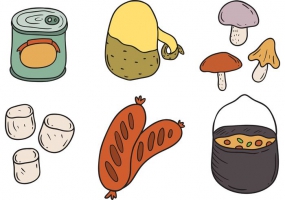
Safe Food Before It Leaves Your Kitchen
Your best bet when packing is to select foods that are lightweight and don't require much preparation. Anything that's labeled "just add water", including powdered drink mixes (milk, hot chocolate, juice), dried pasta, soups and rice, will provide less of a load to carry and no worries for spoiling on the way!
Make sure to take only enough for you and your family. Repackage dried foods into smaller plastic bags. If you take a 3-pound bag of pasta, but your family only needs 1 pound, that defeats the purpose of traveling light! Also, take along the smallest size jar of any condiments you may be bringing, such as ketchup or mustard. And if you have them lying around at home anyway, why not instead grab those extra condiment packets from your last fast-food restaurant visit- they're handy and lightweight!
If you know there won't be safe drinking water available at your campsite, bring along bottled water. If you're stuck without bottled or safe drinking water, boil water for five minutes. Boiling will take care of any biological threats that may be present in the water, but will NOT neutralize chemical pollutants.
Don't Have Time (or a patient stomach) to Prepare Food?
Commercially canned foods weigh more, but if you won't need to carry them far, they offer a great option (just don't forget the can opener!) Tuna, soups, fruit and veggies are all ready-to-eat from the can, or can be heated on a camp stove.
Peanut butter, jelly, crackers, hard cheese, beef jerky, pre-peeled baby carrots and dried fruits are also ready-to-eat, and make for a great snack!
Frozen Foods While Camping?
Yes, it's true! Although a little more effort and planning is required, some frozen foods can make their way into your camping diet. Any food that is frozen, chilled, or requires refrigeration can be placed in a cooler with ice. Pack foods right from the refrigerator just before you leave home. Don't put extra items on sandwiches, especially mayonnaise, until you're ready to eat them. Otherwise, you increase the risk of spoilage and the multiplication of bacteria. If you're in doubt about the food, read the label. If a label reads "keep refrigerated," it may not be safe for backpacking, where a cooler may be too bulky to carry around.
If possible, use one large block of ice in the cooler instead of small cubes, as it will last much longer. When you arrive at the campsite, insulate the cooler with a blanket. If you're camping at the beach, place the cooler under a beach umbrella, and for extra insulation, bury the cooler about half way in the sand. Use a separate cooler for drinks, as this will prevent excess loss of cold air from repeated openings of the food cooler.
Any quick-perishing foods should be closely monitored. Any raw meat, including poultry and fish, most dairy products, eggs, and prepared foods must be stored at 40 degrees Fahrenheit or colder, and should not be left out for more than two hours. If the temperature outside is above 90 degrees Fahrenheit, the food standing time drops to one hour. Also, upon returning home, you may have some leftover food. If there is still ice in the cooler and the food did not sit out for over one hour, go ahead and transfer it to your refrigerator- it's safe. If the ice has melted, do not use any of the leftovers.
Cooking Outdoors
A favorite pastime of campers is fishing. And what better way to celebrate that record (or not so record) catch by serving it up for a tasty dinner! Make sure to cook your fish thoroughly?it should be fairly firm to the touch and should not look translucent. Also, any other meat or poultry you prepare must be thoroughly cooked. By giving your food enough time over the campfire or stove, you'll ensure that those nasty food-poisoning bacteria have been destroyed.
Spy some tasty looking greens in a nearby forest? While they may look like a nice addition to your meal, unless you are experienced at identifying them, leave the wild edibles, mushrooms and fruit for the wildlife.
Everything But the Kitchen Sink
So, it's time to eat. But before you latch on to anything that will find its way to your mouth, you've got to find a way to get that dirt (and who knows what else) off your hands. But there's no running water within miles?what to do?! Well, because you're a thoughtful and prepared camper, this does not present a problem for you. Simply break out that resealable bag you filled with moist towelettes and instant hand sanitizer. Presto! You and your family are ready to enjoy a safe and delicious campfire dinner!
Cleanup--a Bear of a Chore!
While you might rather be exploring, clean up is an important step in being a safe and responsible camper. If possible, burn leftover food in your campfire instead of throwing it in the trash. Food scraps tend to be a favorite of birds, insects, raccoons, and even bears. Don't tempt unwelcome visitors to clean up your campsite for you! And make sure your campfire is completely out by dousing it with water or sand. A small spark can quickly spell disaster.
By preparing ahead of time and using your food safety camping-smarts, you'll help to ensure that you and your family have a great time in the great outdoors!